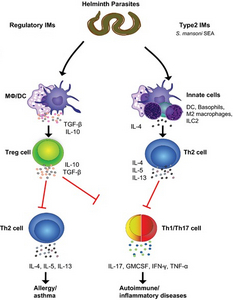Cruz, AA; Cooper, PJ; Figueiredo, CA; Alcantara-Neves, NM; Rodrigues, LC; Barreto, ML
(2017)
Global issues in allergy and immunology: Parasitic infections and allergy.
J Allergy Clin Immunol, 140 (5).
pp. 1217-1228.
ISSN 1097-6825
https://doi.org/10.1016/j.jaci.2017.09.005
SGUL Authors: Cooper, Philip John
|
Microsoft Word (.docx)
Accepted Version
Available under License Creative Commons Attribution Non-commercial No Derivatives. Download (78kB) |
||
![[img]](http://sgultest.da.ulcc.ac.uk/109299/9.hassmallThumbnailVersion/Figure_1.jpg)
|
Image (JPEG) (Figure 1)
Accepted Version
Available under License Creative Commons Attribution Non-commercial No Derivatives. Download (196kB) | Preview |
|
|
Microsoft Word (.docx) (Legend to Figure 1)
Accepted Version
Available under License Creative Commons Attribution Non-commercial No Derivatives. Download (33kB) |
||
![[img]](http://sgultest.da.ulcc.ac.uk/109299/14.hassmallThumbnailVersion/Figure_2.jpg)
|
Image (JPEG) (Figure 2)
Accepted Version
Available under License Creative Commons Attribution Non-commercial No Derivatives. Download (530kB) | Preview |
|
|
Microsoft Word (.docx) (Legend to Figure 2)
Accepted Version
Available under License Creative Commons Attribution Non-commercial No Derivatives. Download (34kB) |
||
|
Microsoft PowerPoint (Figure 3)
Accepted Version
Available under License Creative Commons Attribution Non-commercial No Derivatives. Download (503kB) |
||
|
Microsoft Word (.docx) (Legend to Figure 3)
Accepted Version
Available under License Creative Commons Attribution Non-commercial No Derivatives. Download (30kB) |
||
![[img]](http://sgultest.da.ulcc.ac.uk/109299/4.hassmallThumbnailVersion/Figure-4..jpg)
|
Image (JPEG) (Figure 4)
Accepted Version
Available under License Creative Commons Attribution Non-commercial No Derivatives. Download (135kB) | Preview |
|
|
Microsoft Word (.docx) (Legend to Figure 4)
Accepted Version
Available under License Creative Commons Attribution Non-commercial No Derivatives. Download (52kB) |
||
|
Microsoft Word (.docx) (Figure 5)
Accepted Version
Available under License Creative Commons Attribution Non-commercial No Derivatives. Download (15kB) |
||
|
Microsoft Word (.docx) (Legend to Figure 5)
Accepted Version
Available under License Creative Commons Attribution Non-commercial No Derivatives. Download (29kB) |
||
|
Microsoft Word (.docx) (Table 1)
Accepted Version
Available under License Creative Commons Attribution Non-commercial No Derivatives. Download (59kB) |
||
|
Microsoft Word (.docx) (Table 2)
Accepted Version
Available under License Creative Commons Attribution Non-commercial No Derivatives. Download (77kB) |
||
|
Microsoft Word (.docx) (Clinical Notes Box I)
Accepted Version
Available under License Creative Commons Attribution Non-commercial No Derivatives. Download (64kB) |
||
|
Microsoft Word (.docx) (Clinical Notes Box II)
Accepted Version
Available under License Creative Commons Attribution Non-commercial No Derivatives. Download (77kB) |
Abstract
Allergic diseases are on the increase globally in parallel with a decrease in parasitic infection. The inverse association between parasitic infections and allergy at an ecological level suggests a causal association. Studies in human subjects have generated a large knowledge base on the complexity of the interrelationship between parasitic infection and allergy. There is evidence for causal links, but the data from animal models are the most compelling: despite the strong type 2 immune responses they induce, helminth infections can suppress allergy through regulatory pathways. Conversely, many helminths can cause allergic-type inflammation, including symptoms of "classical" allergic disease. From an evolutionary perspective, subjects with an effective immune response against helminths can be more susceptible to allergy. This narrative review aims to inform readers of the most relevant up-to-date evidence on the relationship between parasites and allergy. Experiments in animal models have demonstrated the potential benefits of helminth infection or administration of helminth-derived molecules on chronic inflammatory diseases, but thus far, clinical trials in human subjects have not demonstrated unequivocal clinical benefits. Nevertheless, there is sufficiently strong evidence to support continued investigation of the potential benefits of helminth-derived therapies for the prevention or treatment of allergic and other inflammatory diseases.
| Item Type: | Article | ||||||
|---|---|---|---|---|---|---|---|
| Additional Information: | © 2017. This manuscript version is made available under the CC-BY-NC-ND 4.0 license http://creativecommons.org/licenses/by-nc-nd/4.0/ | ||||||
| Keywords: | Allergy, asthma, epidemiology, helminths, parasite infection, pathogenesis, Allergens, Allergy and Immunology, Animals, Antigens, Helminth, Clinical Trials as Topic, Disease Models, Animal, Helminthiasis, Helminths, Humans, Hypersensitivity, Immunomodulation, Parasitic Diseases, Therapy with Helminths, Allergy, asthma, parasite infection, helminths, epidemiology, pathogenesis, Allergy, asthma, epidemiology, helminths, parasite infection, pathogenesis, Allergy, 1107 Immunology | ||||||
| SGUL Research Institute / Research Centre: | Academic Structure > Infection and Immunity Research Institute (INII) | ||||||
| Journal or Publication Title: | J Allergy Clin Immunol | ||||||
| ISSN: | 1097-6825 | ||||||
| Language: | eng | ||||||
| Dates: |
|
||||||
| Publisher License: | Creative Commons: Attribution-Noncommercial-No Derivative Works 4.0 | ||||||
| PubMed ID: | 29108604 | ||||||
| Web of Science ID: | WOS:000414304300001 | ||||||
 |
Go to PubMed abstract | ||||||
| URI: | http://sgultest.da.ulcc.ac.uk/id/eprint/109299 | ||||||
| Publisher's version: | https://doi.org/10.1016/j.jaci.2017.09.005 |
Statistics
Actions (login required)
 |
Edit Item |




